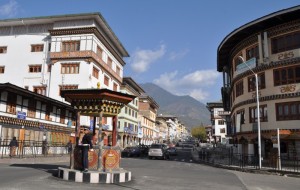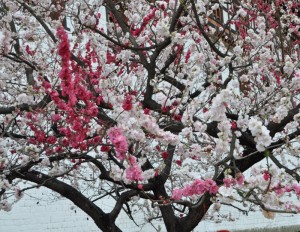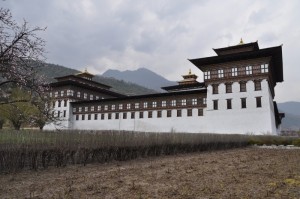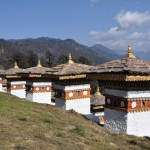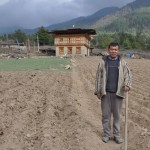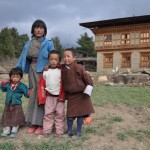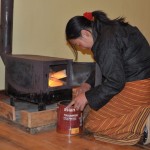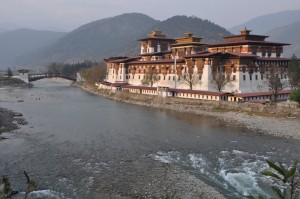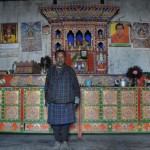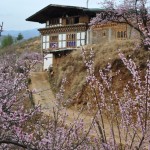Bhutan, also known as the Land of Thunder Dragon, is the one of the most restricted and expensive tourist destinations. Given its spiritual, cultural and natural heritage, Bhutan believes it has something unique and special in the modern world to offer to visitors. It has been on my ‘must-see’ list for a long time. I made an 8-day trip to Bhutan during the Paro Tshechu and visited Paro, Thimpu, Punakha, Wangdu and Haa.
Bhutan
Area: 38,394 square kilometres
Population: 683,407 (2009)
GDP: US$1.27 billion (2009); GDP per capita: US$1,891 (2009) (Source: World Bank); GDP per capita (PPP): US$5,000 (2010 est)
Brief history
Based on archaeological findings, there were settlements in Bhutan in 2000-1500 BC. Prehistorical era of Bhutan can be traced back to 500/600 AD. Buddhism first came to Bhutan in the 7th century when 33rd Tibetan King, Songtsen Gampo ordered the establishment of monasteries in the Himalayan region to subdue evil spirits and spread Buddhism. Then Guru Padmasambhava (the patron saint of Bhutan), popularly known as Guru Rinpoche, visited Bhutan in 747 AD laying the foundation for the community of lamas in Bhutan and firmly established the Vajrayana form of Buddhism imbued with tantric practices.
Until the early 17th century, Bhutan existed as a patchwork of minor warring fiefdoms. Ngawang Namgyal who was installed as the 18th prince-abbot of the Drukpa monastery at Ralung in 1606 gradually emerged as the leader. After his victory over the Tibetans in 1639, he was recognized as the leader of Druk Yul and assumed the title of Zhabdrung and became the temporal and spiritual leader of Bhutan. He unified the country and constructed a number of important monasteries and dzongs. He also installed a dual system of administration i.e. a Desi (civil ruler) and Je Khenpo (the Chief Abbot or spiritual leader). After the reign of Zhabdrung Ngawang Namgyal which ended in 1651, Bhutan was ruled by Desis until 1907 and torn by civil strife. There were also disputes with Tibet, India and the British East India Company.
The establishment of monarchy in 1907 was the watershed event in the history of modern Bhutan. Gongsar Ugyen Wangchuck, son of the 48th Druk Desi, defeated his political enemies and united the country. On 17 December, he was crowned as the First Hereditary King of Bhutan. The process of modernisation began in 1961 when the Third Druk Gyalpo opened up the country to the rest of the world ending the era of self-imposing isolation. The Fourth Druk Gyalpo ruling from 1972 to 2006 introduced political reforms, initiated the drafting of a written constitution for Bhutan and opened the country to tourists in 1974. He created a development philosophy, Gross National Happiness (GNH), which is an interesting concept. He abdicated the throne at the age of 51 in favour of his son who became the Fifth Druk Gyalpo. General elections for the National Council and National Assembly were held in March 2008 and Bhutan adopted its first written Constitution in July the same year.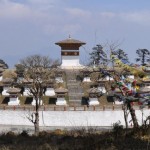
Since opening its door to visitors in 1974, Bhutan has been pursuing a cautious ‘high value, low volume’ tourism policy: only those who can afford to spend at least US$250 a day can enter and all visits must be handled by Bhutanese travel companies. It had 287 arrivals in 1974 and 27,636 by 2008.
March 18-19:- Paro (GMT +6)
Paro Tshechu
I took the 6:50am flight from Bangkok, Thailand to Paro (2280m) via Dhaka, Bangladesh. Once the plane enters the Bhutan Himalayan region, it flies along a narrow path between two mountain ranges and takes almost a 90-degree turn just before landing at the Paro valley. A scenic but scaring flight!
Paro is a beautiful valley rich in culture, scenic beauty and abounds in myths and legends. The valley is often known as the ‘rice bowl’ of the Kingdom as it produces a bulk of the red rice from its fertile terraced fields. Paro is also known for the production of wheat, millet, potatoes, apples and seasonable vegetables.
 I was greeted by Yangse, my guide and a driver. The hotel I was supposed to stay had some problems and I had to move to another hotel which is old with basic facilities. After lunch, I went to the festival ground at the goenpa (a monastery above the Rinpung Dzong) where I spent two hours watching the performances. Each mask dance has its own significance and is performed by monks and villagers. The festival is held to commemorate the events in the life of Guru Rinpoche. Though the mask dances are interesting to watch, I did not know the meaning and its significance. I think a simple programme/leaflet with brief explanation can be made available at minimal cost. Or the guide can provide such information. Groups of women and men from the villagers also sang during the intervals.
I was greeted by Yangse, my guide and a driver. The hotel I was supposed to stay had some problems and I had to move to another hotel which is old with basic facilities. After lunch, I went to the festival ground at the goenpa (a monastery above the Rinpung Dzong) where I spent two hours watching the performances. Each mask dance has its own significance and is performed by monks and villagers. The festival is held to commemorate the events in the life of Guru Rinpoche. Though the mask dances are interesting to watch, I did not know the meaning and its significance. I think a simple programme/leaflet with brief explanation can be made available at minimal cost. Or the guide can provide such information. Groups of women and men from the villagers also sang during the intervals.
 |
 |
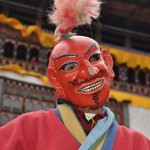 |
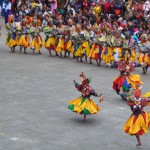 |
 But the most interesting part for me is people-watching. The festival remains an important occasion for the local community despite the presence of hundreds of tourists. To reinforce Bhutan’s identity, Bhutanese law requires all its citizens to wear the national dress in public areas (including the Dzongs) and as formal wear.
But the most interesting part for me is people-watching. The festival remains an important occasion for the local community despite the presence of hundreds of tourists. To reinforce Bhutan’s identity, Bhutanese law requires all its citizens to wear the national dress in public areas (including the Dzongs) and as formal wear.
The display of colures of the costume is stunning. Men all wear gho which is knee-length robe tied at the waist by a keyra (a fabric belt) with a kabney (a scarf), the colour of which tells the rank of the person in society. Women’s costume is even more colourful and elaborate: they wear a tego (a jacket) on top of a wonju (a long-sleeved blouse) and have a kira (an ankle-length dress) with a sash hanging over their shoulder. I am fascinated by the colour combination. It is enchanting to see the locals dressed in their best clothes and enjoy the festival with their family.
The guide dropped me back in my hotel at 4pm. As I felt energetic despite the lack of sleep the night before, I decided to take a 20-minute walk to the town centre which provides a glimpse of the life of the common people in the valley. People seem to live well with big and well-kept traditional houses.
The highlight of the festival falls on the last day when the thangka of Guru Rinpoche is hung in front of the goenpa from about 3am to sunrise. Locals get up early and file pass the thangka to seek blessing from the abbots. I got up at 4:30am on March 19 and arrived at the festival ground at 5am only to find thousands of people swarming the whole area. It was an exciting moment when I saw the huge thangka in daybreak with numerous Bhutanese standing solemnly at its bottom praying or touching it. The Chief Abbot and monks in yellow and red robes set in the middle of the ground. There were so many people that I could hardly see what was happening. I went to a vantage spot on a mould behind the goenpa and watched the rising sun throwing lights on the Dzong. Unfortunately, my battery went dead when I was about to take a picture of the thangka. I looked desperately for someone with a similar camera and managed to find a German tourist with the same model. He kindly lent me his battery and I took a couple of photos before returning the battery to him.
 After breakfast, I departed for Taktsang Monastery (popularly known as Tiger’s Nest) (3100m) around 8:30am. Undoubtedly, it is Bhutan’s most revered temple as well as it’s most iconic and photographed site. It is said that Guru Rinpoche arrived here on the back of a tigress (which was his favourite consort) and mediated at this monastery. It is a pilgrim site for all Bhutanese who visit it at least once in their lifetime. Perched on the side of a 900m cliff above the Paro valley, the monastery is an architectural gem. The main structure of the monastery was damaged in a fire in 1998 and has been restored to its former glory.
After breakfast, I departed for Taktsang Monastery (popularly known as Tiger’s Nest) (3100m) around 8:30am. Undoubtedly, it is Bhutan’s most revered temple as well as it’s most iconic and photographed site. It is said that Guru Rinpoche arrived here on the back of a tigress (which was his favourite consort) and mediated at this monastery. It is a pilgrim site for all Bhutanese who visit it at least once in their lifetime. Perched on the side of a 900m cliff above the Paro valley, the monastery is an architectural gem. The main structure of the monastery was damaged in a fire in 1998 and has been restored to its former glory.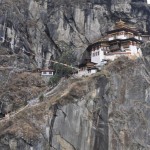
It was a lovely, sunny and warm day and I had a lovely 2-hour hike to the Taksang monastery. The last 30-minute walk involving hundreds of steps up and down is exhausting. But the views are stunning and most photogenic. After spending an hour visiting all the temples and halls, I descended to the cafeteria facing the cliff. The vegetable lunch was delicious and the view of the monastery is unrivalled. It’s an easy descend and I took just over an hour to reach the car park. At my request, the guide took me to the National Museum of Bhutan which has a good collection of thangkas, stamps, icons, etc. It is housed in an old dzong which served as a watch tower with interesting features.
 |
March 20: Paro – Thimphu (driving 2 hrs)
I spent two hours in the Rinpung Dzong and the goenpa which was deserted after the festival. I was by myself without another soul in sight (what a contrast!) and took time to appreciate the elegant and colourful Bhutanese architecture. The guide explained the normal layout and common features of a dzong including a large central tower (utse), a courtyard (dochery) and the murals found at the entrance i.e. the four best friends, the Divine Madman, the guardians of the four directions, the wrathful gatekeepers, the Lord of Power etc. Before leaving for Thimphu (2320m), the capital, I asked the guide to take me to the Sunday market in Paro where I brought some sweet potatoes, bananas and black grapes.
The road to Thimphu is well-paved. I reached the capital after a comfortable 2-hour drive. After a nice lunch in a well-known Bhutanese restaurant, I was taken to see the usual tourist attractions.
Changgangka Monastery– Built in the 12th century, it is the oldest monastery in Thimphu. Though small, it is imposing and has an excellent view of the capital. Unfortunately, the main hall was locked as the monk with the key had gone for lunch.
Radio Tower View Point– It is a favourite spot for a panoramic view. But a hill fire nearby emitted so much smoke that it was impossible for a clear view.
Takin Reserve– Takin is chosen as the national animal of Bhutan for its uniqueness and its association with the country’s religious history and mythology.
Thimphu (Tashichho) Dzong– Also known as the ‘Fortress of the Glorious Religion’, the Dzong was first built in 1641 and rebuilt in 1965. It is both the administrative centre of the government where the King has his office and the summer residence of the Chief Abbot and his 500 followers.
The National Memorial Chorten– It is a sacred shrine built in 1974 in memory of the Third Druk Gyalpo who is regarded as the ‘Father of Modern Bhutan’ and ruled from 1952 to 1972.
Semtokha Dzong– It was the first dzong built by Zhabdrung Ngawang Namguyal in 1620. It is small but beautiful standing on a lofty ridge outside the town. One chamber houses with a remarkable statute of Chengris and the paintings on the wall are beautiful and well-preserved.
I took a walk before dinner and found the buildings along the main street colourful and elegant with a blend of Bhutanese painting and patterns and modern look.
March 21: Thimphu – Phobjikha (driving 4 hrs)
The drive to the Phobjikha valley, the winter home of the black-necked cranes from Tibet, is most scenic. On the way, I stopped at the Dochula Pass at 3100m for its fantastic views and to see the iconic and photogenic 108-chorten cluster built in memory of those who died during the war with Assam. It’s hazy and there was no postcard view of the mountain ranges. But I felt peaceful and calm.
I visited the Nature Conservation Centre in the Phobjikha valley and watched a good documentary on the black-necked cranes which is an endangered species with only 800 left in the world. I took a leisure 2-hour walk in the valley and watched some farmers working in a potato field. The farmer who speaks good English came to greet me and invited me to see his house and meet his children. I spent a lovely time with his children. 
On my way back to the guest house, I met a group of lovely school girls on their way home. They asked me to take pictures and were excited when I showed them their photos. One of the girls asked for picture money: it was the first time someone had made such a request. The eldest girl of the group immediately told her off. I had a great afternoon interacting with the locals though I had not been able to talk with them in their language.
The valley surrounded by beautiful mountains on all sides, is the most beautiful and perfect valley I have ever visited. The lower slopes on one side of the valley are treeless while other sides are all covered with lovely pine trees. There are several streams flowing through the wetland which is dotted with cows and a lone crane which has not returned with its companions to Tibet. I love to spend a few days or weeks in the valley and do something for the community in relation to conservation or sustainable tourism development which can benefit the local community. But given the Bhutanese government’s restrictive policy, I do not think it is easy to come and work as a volunteer.
March 22: Phobjikha Valley – Wande (driving 3 hrs)
The temperature dropped below zero and the valley was white covered by a sheet of frost. I watched sunrise enjoying a cup of hot tea. I asked my guide to make a stop at the Gangtey Monastery which was founded in 1613 by Gyalse Pema Thinley. The monastery built in traditional Bhutanese style is worth visiting. It also has commanding views over the valley. I saw two young student monks sitting by a window and tried to take a photo. One of the boys asked for money. This was the second time a child was asking for photo money. I am particularly sad to see a young student monk being corrupted by money. Can Bhutanese escape the lust for money and materialism?
 |
 |
 |
 |
I visited the Wangduephdorang Dzong (1240m), which occupies a strategic position at a hilltop in the shape of a sleeping elephant. The dzong, the third oldest dzong founded by Zhabdrung Ngawang Namguyal in 1638, played a critical role in unifying the western, central and southern Bhutanese Dzongkhags (administrative districts). I saw a picturesque old village perched on the hillside on the other side of the river. My guide said it’s the oldest village in Bhutan and was established during the construction of the dzong.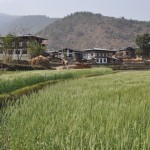
I had lunch at a local restaurant at Wande which offers a superb view of the valley with green terraced fields and village houses. A short hike to the Chimi Lhakhang Temple takes me through the picturesque valley. This temple built in 1499 was dedicated to Lama Drukpa Kunley (also known as the ‘Divine Madman’ who used humour, songs and outrageous behaviour to dramatise his teachings). It is widely believed that childless couples who pray at this temple are usually blessed with children. My tour finished around 3pm and I spent the rest of the afternoon in the hotel tidying up my trip notes on Ethiopia.
March 23: Wande – Punakha (driving 30 minutes)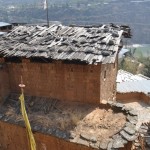
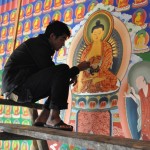 I requested the guide to take me to see Bhutan’s oldest village. I arrived at a small square after a 10-minute hike uphill. Some villagers were drying millets or rice in the square. My guide asked a family for permission to see their house which happens to be one of the oldest houses in the village (over 200 years old). The house is spacious, fairly tidy and clean. The ground floor is used for storage. Three families share the second and third floor while the rooftop is used for drying meat, hay etc. I reached the top of the village and saw an old temple under restoration. Two young artists were painting the image of Lord Buddha on the walls. They are graduates of an art school in Thimphu. I wished them luck and took a few pictures for them.
I requested the guide to take me to see Bhutan’s oldest village. I arrived at a small square after a 10-minute hike uphill. Some villagers were drying millets or rice in the square. My guide asked a family for permission to see their house which happens to be one of the oldest houses in the village (over 200 years old). The house is spacious, fairly tidy and clean. The ground floor is used for storage. Three families share the second and third floor while the rooftop is used for drying meat, hay etc. I reached the top of the village and saw an old temple under restoration. Two young artists were painting the image of Lord Buddha on the walls. They are graduates of an art school in Thimphu. I wished them luck and took a few pictures for them.
I went to a bank in Punakha to change money. The banking system is under-developed and I spent some 40 minutes waiting the staff to obtain the rate of exchange for the day from the bank’s headquarters in Thimphu. Another interesting experience!
 |
 |
 |
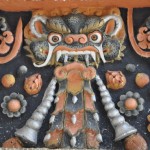 |
 |
 |
Highlights of the day are my visit to the Punakha Dzong and a temple with 108-chorten. Punakha Dzong, also known as the ‘Palace of Happiness’, is regarded as the most beautiful and well-known dzong connected with the country’s historical traditions and houses sacred artifacts. Built at the junction of two rivers namely the Mo Chi (mother) River and the Po Chu (father) River, by Zhabdrung Ngawang Namguyal in 1637, the dzong is 600 ft long and 240ft wide. The embalmed body of Zhabdrung Ngawang Namguyal is kept at the Dzong. It is the winter residence of the Chief Lama of Bhutan. The architecture is impressive and the statue of Buddha in the main hall is the largest in Bhutan.
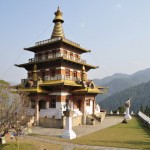 The 108-chorten temple perched on the top of a hill, affords fantastic views of the mountains, valleys and rivers in the area. The 30-minute hike through terraced fields and a forest is very pleasant.
The 108-chorten temple perched on the top of a hill, affords fantastic views of the mountains, valleys and rivers in the area. The 30-minute hike through terraced fields and a forest is very pleasant.
Before returning to the hotel, I visited another chorten built in Nepali style in the town centre.
March 24: Punaka – Paro (driving 3 hrs)
During breakfast, I had an interesting discussion with a Canadian who is running a NGO in Bhutan. On the way back to Paro, we stopped at the Dochula Pass for tea. Once again, it’s hazy and impossible to see the mountain ranges which are described to be most beautiful. I met two ladies from India who are on a study trip and had a chat over the education system in Bhutan. Apparently, many Bhutanese students go to study in India and Indians are also advising the Bhutanese government on how to further develop its education system for students after class 10.
 The drive back to Paro was smooth. After lunch, I went to Drukgyel Dzong built by Zhabdrung Ngawang Namguyal in 1646 to commemorate his victory over the Tibetan invasions. The dzong is now a ruin as a result of a fire in 1951. But I find the ruin majestic and atmospheric. On a clear day, it is possible to see Bhutan’s highest peak Jomolhari (7314m). Though it’s too cloudy to see the peak, the scenery and setting remain impressive. I do not think restoration of the dzong to its former glory is necessary. A beautiful ruin can be just memorable and impressive.
The drive back to Paro was smooth. After lunch, I went to Drukgyel Dzong built by Zhabdrung Ngawang Namguyal in 1646 to commemorate his victory over the Tibetan invasions. The dzong is now a ruin as a result of a fire in 1951. But I find the ruin majestic and atmospheric. On a clear day, it is possible to see Bhutan’s highest peak Jomolhari (7314m). Though it’s too cloudy to see the peak, the scenery and setting remain impressive. I do not think restoration of the dzong to its former glory is necessary. A beautiful ruin can be just memorable and impressive.
My final stop of the day is the Kychu Lhakhang, one of the oldest temple in Bhutan. Built in the 7th century, it is one of the 108 temples built by Songtsen Gyampo to subdue the ogress that lay across the whole of the Himalayas. The statue of Buddha is most beautiful. The temple is not large but well-kept, clean and spiritual. There is second temple in the same style built by the Royal Grandmother Ashi Kezang Choden Wangchuk. I finished my day with a Bhutanese massage at the spa of the hotel before dinner. Another nice and relaxing day.
March 25: Paro – Haa (driving 5 hrs)
Haa (2700m), also known as ‘the Hidden Land Rice Valley’ was the ancient centre of trade with Yatung in the Chumbi valley in Tibet. According to the driver, it only takes two days to walk to the Chinese border. Haa has been opened to tourist since 2002. The drive along the winding road is most scenic and enjoyable as there are hardly any cars on the road. As three sections of the road were under repair, it took us two and a half hours to reach Haa.
I asked my guide to be the translator. I learn about the history of the house, her son and two daughters, their life in the village and the family income. With two sources of income (from the sale of potatoes and butter/cheese), she can make about 50,000 rupees a year. But this is not enough to send the three children to study in town. Her husband takes up building jobs when available. Her 84-year old father-in-law looks healthy and young for his age. She invited me to stay for lunch and to meet her sister-in-law and her friend. Her three children also came back for lunch.
I had a great time meeting the locals who are friendly, happy and welcoming. She invited me to adopt one of her daughters (i.e. a god-child) and stay in the village instead of going to Nepal. I promised to come back on my next visit to Bhutan – perhaps I can go to Tibet from there!
Her house is clean and the butter and cheese she made is fresh and delicious. I brought all the butter and cheese available and gave them as gift to my guide and driver. I also gave some money to her three children for them to purchase books. I took some pictures of these lovely people (I also had the photos developed in Paro and asked my guide to give them to the family on her next visit to Haa).
After lunch, I had a brief visit to the Lhakhang Karpo (or the white temple) which was built in the 7th century and is now under restoration. I paid a brief visit to a modern dzong which has been turned into a shopping centre for Indian goods. I returned to Paro and finished off my visit to Bhutan with a simple dinner in a farm house. The food is nice and simple with plenty of fresh vegetables and chili cheese. The farmer suggested me take a hot stone bath for 500 rupees. I did not take up his offer but might try on my next visit. I left Bhutan for Nepal the following day.
Remarks
Bhutan is a different world! I had a most leisure trip with my day finishing around 3 to 4 pm. Life is simple in this unearthly kingdom. I have done quite a lot in eight days but there is much more to see in this unique mountain kingdom.
I am fascinated by its isolation and history and impressed by its recent developments. The road to modernisation and democracy has been successful and interesting. The country is clean, tidy and peaceful with a strong national identity. Its emphasis on GNH is admirable. The people I have met in town and villages look happy and healthy. The young ones are well-dressed and receive education. I am surprised that English is the medium of instruction in school for many subjects. Even some young kids can speak English. I am pleased to see the government’s emphasis on keeping the country clean and green. Things seem to work generally though the banking system is inefficient.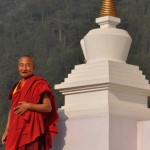
While I can see the Government’s rationale for pursuing a ‘high value and low volume’ tourism policy, I do not like the existing arrangements. The decision to limit the number of visitors makes sense as the infrastructure, the road system in particular are inadequate to cater for mass tourism and heavy traffic. A massive flow of tourists will likely have an adverse impact on a small territory with a population of 700,000. But equally, it might not be a good idea to be the destination only for the rich or grey-hair affluent travellers. I hope the Government can review the policy.
In my view, given the number of hotels and beds and the spread of the attractions, there is room to have more tourists especially during the low season. At present, many tourists go to the few places I have visited on this trip. But I am sure many would be delighted to spend more time and visit the less developed and remote areas, This would help spreading the tourism revenue to more communities. Also instead of imposing a strict daily limit, an overall minimum for the whole duration of stay (which can still be based on an average daily rate) might provide greater flexibility for a consumer. For example, a tourist can choose to splash on a luxurious hotel in Paro one day; take a 2-star hotel on the second day followed by a night with a family in a village on the third. Also a lower overall rate can be set for those who spend a longer period in the country and outside the peak season. In this way, the service provided by hotels, restaurants, car companies, tour operators etc can have business throughout the year.
Bhutan looks like a paradise – beautiful, picturesque, peaceful, tranquil and stable. I do not know the country well but feel it is in transition. It is a challenging task to keep its national identity, characteristics and lifestyle while embracing economic development and modernism in a cyber era. I hope to return one day to see the rest of the country and to gain a better understanding of this unique mountain kingdom.













